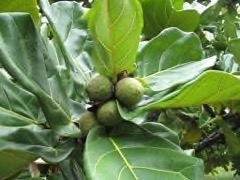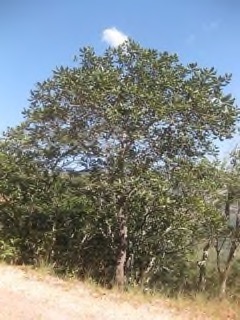 |
|
Steven Haw wikimedia.org |
 |
| Ton Rulkens wikimedia.org |
Translate this page:
Summary
Wild Loquat or Uapaca kirkland is a tropical small tree about 5-12 m tall with a rounded crown and dark gray, rough bark. It can be evergreen or semi-deciduous. The branches are multiple and spreading and the bole is short and stout. The leaves are leathery, oval, and scattered or clustered at terminal branches. The flowers are greenish-yellow. The fruits are round and rusty-yellow. Root infusion is used in the treatment of indigestion and dysentery. The fruits can be eaten raw or cooked. It is fleshy, sweet, and delicious. It can also be made into wine, cakes, porridge. The tree is planted for soil erosion control, as a shade tree, and as an ornamental. The roots yield blue dye and the leaves are used as a cockroach repellent. The wood, being hard, durable and resistant to termite attacks, is ideal for general carpentry, furniture, house building, carvings and boxes, and many others. If not for the said uses, it is used as fuel and for making charcoal.
Physical Characteristics

 Uapaca kirkiana is an evergreen Tree growing to 12 m (39ft) by 12 m (39ft) at a medium rate.
Uapaca kirkiana is an evergreen Tree growing to 12 m (39ft) by 12 m (39ft) at a medium rate.
See above for USDA hardiness. It is hardy to UK zone 10. The plant is not self-fertile.
Suitable for: light (sandy) and medium (loamy) soils, prefers well-drained soil and can grow in nutritionally poor soil. Suitable pH: mildly acid and neutral soils and can grow in very acid soils.
It can grow in semi-shade (light woodland) or no shade. It prefers moist soil.
UK Hardiness Map
US Hardiness Map
Synonyms
Uapaca albida De Wild. Uapaca benguelensis M?ll.Arg. Uapaca goetzei Pax Uapaca greenwayi Suesseng. U
Plant Habitats
Edible Uses
Edible Parts: Fruit
Edible Uses: Drink
Fruit - raw or cooked[398 ]. Fleshy and sweet, it has a delicious flavour[398 ]. The fruit is commonly eaten fresh and is highly regarded[301 , 303 ]. It can also be used for brewing a very pleasant wine or for making cakes that are fried and eaten[301 ]. The juice of the fruit is mixed with sorghum meal to form a thin, orange-flavoured porridge[301 ]. The fruit pulp is juicy, honey-like, very tasty and somewhat reminiscent of pears[301 ]. Dried fruits have a toffee-like flavour[301 ]. The fruit is about 4cm x 4cm.
References More on Edible Uses
Medicinal Uses
Plants For A Future can not take any responsibility for any adverse effects from the use of plants. Always seek advice from a professional before using a plant medicinally.
Antidiarrhoeal Dysentery
An infusion made from the roots is used to treat indigestion and dysentery[418 ].
References More on Medicinal Uses
The Bookshop: Edible Plant Books
Our Latest books on Perennial Plants For Food Forests and Permaculture Gardens in paperback or digital formats.

Edible Tropical Plants
Food Forest Plants for Hotter Conditions: 250+ Plants For Tropical Food Forests & Permaculture Gardens.
More

Edible Temperate Plants
Plants for Your Food Forest: 500 Plants for Temperate Food Forests & Permaculture Gardens.
More

More Books
PFAF have eight books available in paperback and digital formats. Browse the shop for more information.
Shop Now
Other Uses
Charcoal Containers Dye Fencing Fuel Furniture Repellent Soil conditioner Soil stabilization Wood
Agroforestry Uses: The tree is planted for erosion control, shade, shelter, living fence and as an ornamental. It forms a mutual association with mycorrhizae and act as a soil improver and is an important agro-forestry tree[418 ]. Other Uses A blue dye is made from the roots[303 ]. The leaves are used as a cockroach repellent in homes[303 , 418 ]. Wood is light with white sapwood and reddish-brown, figured heartwood. It is hard and durable, has a straight grain, saws clean and can be planed to a smooth finish. It glues well, holds nails firmly and takes a clear varnish finish. Suitable for general carpentry, house building and domestic utensils, furniture and joinery, carvings and boxes. It is termite resistant[303 ]. The wood is used as a fuel and to make charcoal[418 ]. Charcoal made from the wood is highly regarded, and many trees are cut specifically for this purpose[303 ]. It is also a good source of firewood[303 ].
Special Uses
Food Forest
References More on Other Uses
Cultivation details
The plant is are found wild at an altitude of 500 - 2,000 metres in the tropics[303 ]. It grows best where the mean annual temperature is within the range of 18 - 24°c, though it tolerates 12 - 32°c. It prefers a mean annual rainfall of 700 - 1,500mm, but can tolerate 500 - 2,000mm[303 , 418 ]. Plants are very intolerant of frost[323 ]. Prefers a sunny position, tolerating light shade[418 ]. Tolerant of poor, shallow, gravel and sandy loam soils[303 ]. Normally found in acidic soils with a pH 4 - 6.5[303 , 418 ]. Dioecious - both male and female forms need to be grown if seed is required[303 ].
References Carbon Farming Information and Carbon Sequestration Information
Temperature Converter
Type a value in the Celsius field to convert the value to Fahrenheit:
Fahrenheit:
The PFAF Bookshop
Plants For A Future have a number of books available in paperback and digital form. Book titles include Edible Plants, Edible Perennials, Edible Trees,Edible Shrubs, Woodland Gardening, and Temperate Food Forest Plants. Our new book is Food Forest Plants For Hotter Conditions (Tropical and Sub-Tropical).
Shop Now
Plant Propagation
Seed - needs to be sown fresh since it has a limited viability of about 3 weeks[303 ]. Germination is usually good, especially if the seed is scarified first[303 ]. Young seedlings need to be given some shade[303 ]. Division of suckers[303 ]. Cuttings
Other Names
If available other names are mentioned here
Hekela msuku, Kanono, Macunapa, Mahobohobo, Masuku, Matue, Mesange, Mguhu, Mgulu, Mgusu, Mkusu, Mompangwe, Msuku, Mtjunku, Mtoto, Muguhu, Musukuti, Umugusu,
Native Range
AFRICA: Tanzania, Democratic Republic of the Congo, Mozambique, Malawi, Zambia, Zimbabwe.
Weed Potential
Right plant wrong place. We are currently updating this section.
Please note that a plant may be invasive in one area but may not in your area so it's worth checking.
Conservation Status
IUCN Red List of Threatened Plants Status : This taxon has not yet been assessed

Growth: S = slow M = medium F = fast. Soil: L = light (sandy) M = medium H = heavy (clay). pH: A = acid N = neutral B = basic (alkaline). Shade: F = full shade S = semi-shade N = no shade. Moisture: D = dry M = Moist We = wet Wa = water.
Now available:
Food Forest Plants for Mediterranean Conditions
350+ Perennial Plants For Mediterranean and Drier Food Forests and Permaculture Gardens.
[Paperback and eBook]
This is the third in Plants For A Future's series of plant guides for food forests tailored to
specific climate zones. Following volumes on temperate and tropical ecosystems, this book focuses
on species suited to Mediterranean conditions—regions with hot, dry summers and cool, wet winters,
often facing the added challenge of climate change.
Read More
Expert comment
Author
M?ll.Arg.
Botanical References
Links / References
For a list of references used on this page please go here
A special thanks to Ken Fern for some of the information used on this page.
Readers comment
| Add a comment |
|
If you have important information about this plant that may help other users please add a comment or link below. Only comments or links that are felt to be directly relevant to a plant will be included. If you think a comment/link or information contained on this page is inaccurate or misleading we would welcome your feedback at [email protected]. If you have questions about a plant please use the Forum on this website as we do not have the resources to answer questions ourselves.
* Please note: the comments by website users are not necessarily those held by PFAF and may give misleading or inaccurate information.
To leave a comment please Register or login here All comments need to be approved so will not appear immediately.
|
Subject : Uapaca kirkiana
|
|
|
|